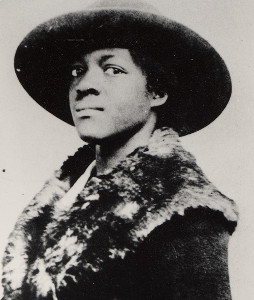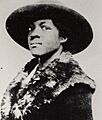Mabel Hampton facts for kids
Quick facts for kids
Mabel Hampton
|
|
|---|---|

Hampton c. 1919
|
|
| Born | May 2, 1902 |
| Died | October 26, 1989 (aged 87) |
| Nationality | American |
| Organization | Lesbian Herstory Archives |
| Known for | Dancing, gay activism, domestic work |
| Movement | Harlem Renaissance |
Mabel Hampton (May 2, 1902 – October 26, 1989) was an American dancer and activist. She was known for her dancing during the Harlem Renaissance. She also volunteered for groups supporting Black people and people seeking equal rights. Mabel Hampton was an important helper for the Lesbian Herstory Archives.
Early Life
Mabel Hampton was born in Winston-Salem, North Carolina, on May 2, 1902. Her mother passed away when Mabel was very young. She was then raised by her grandmother for seven years. When she was seven, her grandmother also passed away. Mabel then traveled to New York City. She lived with her aunt and uncle for a short time.
After about a year, she left and found a family in New Jersey to live with. She stayed with them from age 8 to 17.
Later Life and Career
In the 1920s, Mabel Hampton became a dancer. She performed in shows with other Black artists during the Harlem Renaissance. She danced alongside famous stars like Gladys Bentley. Mabel performed at a club called "The Garden of Joy." She also sang in the Lafayette Theater Chorus. Through this work, she met many other dancers, artists, and people who were also working for equal rights.
When there was less demand for chorus line dancers, Mabel Hampton changed careers. She became a cleaning woman and a hospital attendant. She worked for families for a long time. During this time, Mabel met Joan Nestle, who was the daughter of one of the families. They became very good friends.
In 1932, Mabel Hampton met Lillian B. Foster. Lillian became her partner for 46 years. They had a loving and lasting relationship. Mabel called Lillian "Little Bear," and Lillian called Mabel "Big Bear." They stayed together until Lillian passed away in 1978.
Mabel Hampton also helped with the New York Defense Recreation Committee in 1943. She collected items like cigarettes for American soldiers during World War II. She did this work with her friends who also supported equal rights.
Activism for Equal Rights
Mabel Hampton was a strong activist for equal rights for all people. In 1973, she joined the Lesbian Herstory Archives in New York City. This organization was started by her good friend, Joan Nestle. Mabel gave many personal items and shared her life stories for the Archives. These stories helped others learn about the past. She also worked for SAGE, a group that helps older people in the LGBTQ+ community.
Even though she worked hard for her income, Mabel Hampton supported many causes. She gave money to the Martin Luther King Memorial Fund. She also supported groups working for gay and lesbian rights. She went to performances by the Negro Opera Company. Mabel appeared in films like Silent Pioneers and Before Stonewall. These films showed the journey for gay rights.
In 1979, Mabel Hampton marched in the first national gay and lesbian march in Washington D.C.. She spoke at the New York City Lesbian and Gay Pride Parade in 1984. There, she famously said: "I, Mabel Hampton, have been a lesbian all my life, for 82 years, and I am proud of myself and my people. I would like all my people to be free in this country and all over the world, my gay people and my Black people."
In 1985, she was named the grand marshal for the New York City Gay Pride March. That same year, she received a special award for her lifetime of achievements. This award came from the National Coalition of Black Lesbians and Gays. Mabel also went to a conference for older lesbians in 1987. There, she shared more of her personal stories.
Mabel Hampton passed away from pneumonia on October 26, 1989. She was at St. Luke's-Roosevelt Hospital Center.
Legacy
After her death, Mabel Hampton was featured in the documentary Not Just Passing Through.
In 1976, Mabel Hampton gave many valuable items to the Lesbian Herstory Archives. These included letters, old papers, and books she had collected. These items helped show what life was like for Black lesbians during the Harlem Renaissance. Many of these resources can still be seen at the Archives today.
After she passed away, Mabel was honored on the front page of the Lesbian Herstory Archives Newsletter in January 1990. This newsletter celebrated her life and what she left behind.
In 1992, Joan Nestle gave a special lecture about Mabel Hampton's life. It was called "I Lift My Eyes to the Hill": the Life of Mabel Hampton as Told by a White Woman. This lecture was part of the CUNY Center for Lesbian and Gay Studies.
Images for kids
See also
 In Spanish: Mabel Hampton para niños
In Spanish: Mabel Hampton para niños


